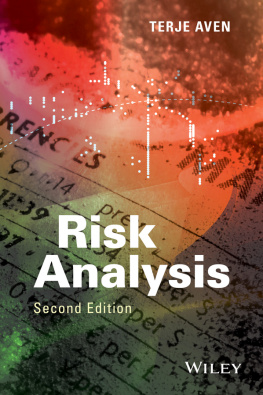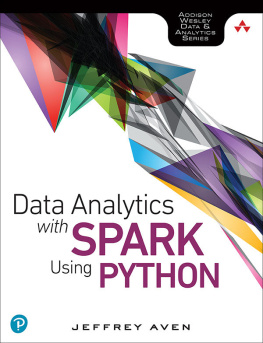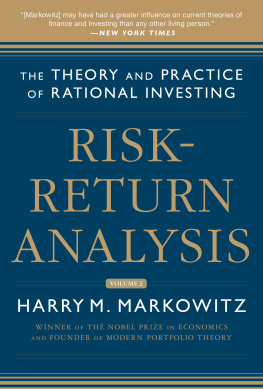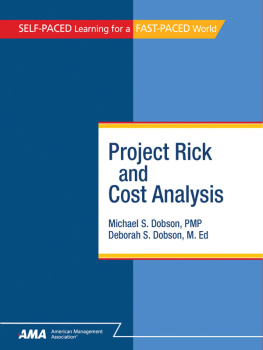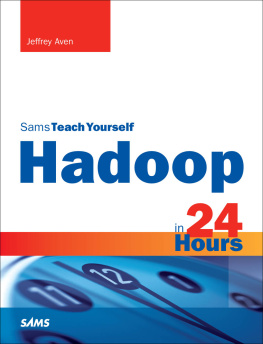Aven - Risk Analysis
Here you can read online Aven - Risk Analysis full text of the book (entire story) in english for free. Download pdf and epub, get meaning, cover and reviews about this ebook. City: Chichester, year: 2015, publisher: John Wiley & Sons, Incorporated, genre: Romance novel. Description of the work, (preface) as well as reviews are available. Best literature library LitArk.com created for fans of good reading and offers a wide selection of genres:
Romance novel
Science fiction
Adventure
Detective
Science
History
Home and family
Prose
Art
Politics
Computer
Non-fiction
Religion
Business
Children
Humor
Choose a favorite category and find really read worthwhile books. Enjoy immersion in the world of imagination, feel the emotions of the characters or learn something new for yourself, make an fascinating discovery.
- Book:Risk Analysis
- Author:
- Publisher:John Wiley & Sons, Incorporated
- Genre:
- Year:2015
- City:Chichester
- Rating:3 / 5
- Favourites:Add to favourites
- Your mark:
- 60
- 1
- 2
- 3
- 4
- 5
Risk Analysis: summary, description and annotation
We offer to read an annotation, description, summary or preface (depends on what the author of the book "Risk Analysis" wrote himself). If you haven't found the necessary information about the book — write in the comments, we will try to find it.
Risk Analysis — read online for free the complete book (whole text) full work
Below is the text of the book, divided by pages. System saving the place of the last page read, allows you to conveniently read the book "Risk Analysis" online for free, without having to search again every time where you left off. Put a bookmark, and you can go to the page where you finished reading at any time.
Font size:
Interval:
Bookmark:

This edition first published 2015
2015 John Wiley & Sons, Ltd
Registered office
John Wiley & Sons Ltd, The Atrium, Southern Gate, Chichester, West Sussex, PO19 8SQ, United Kingdom
For details of our global editorial offices, for customer services and for information about how to apply for permission to reuse the copyright material in this book please see our website at www.wiley.com.
The right of the author to be identified as the author of this work has been asserted in accordance with the UK Copyright, Designs and Patents Act 1988.
All rights reserved. No part of this publication may be reproduced, stored in a retrieval system, or transmitted, in any form or by any means, electronic, mechanical, photocopying, recording or otherwise, except as permitted by the UK Copyright, Designs and Patents Act 1988, without the prior permission of the publisher.
Wiley also publishes its books in a variety of electronic formats. Some content that appears in print may not be available in electronic books.
Designations used by companies to distinguish their products are often claimed as trademarks. All brand names and product names used in this book are trade names, service marks, trademarks or registered trademarks of their respective owners. The publisher is not associated with any product or vendor mentioned in this book.
Limit of Liability/Disclaimer of Warranty: While the publisher and author(s) have used their best efforts in preparing this book, they make no representations or warranties with respect to the accuracy or completeness of the contents of this book and specifically disclaim any implied warranties of merchantability or fitness for a particular purpose. It is sold on the understanding that the publisher is not engaged in rendering professional services and neither the publisher nor the author shall be liable for damages arising herefrom. If professional advice or other expert assistance is required, the services of a competent professional should be sought.
Library of Congress Cataloging-in-Publication Data
Aven, Terje.
Risk analysis / Terje Aven. Second edition.
pages cm
Previous edition: 2008.
Includes bibliographical references and index.
ISBN 978-1-119-05779-6 (cloth)
1. Risk assessmentMathematical models. 2. RiskMathematical models.
3. UncertaintyMathematical models. I. Title.
HD61.A938 2015
338.5dc23
2015018045
A catalogue record for this book is available from the British Library.
ISBN: 9781119057796
This book is about risk analysisbasic ideas, principles and methods. Both theory and practice are covered. A number of books exist presenting the many risk analysis methods and tools, such as fault tree analysis, event tree analysis and Bayesian networks. In this book we go one step back and discuss the role of the analyses in risk management. How such analyses should be planned, executed and used, such that they meet the professional standards for risk analyses and at the same time are useful in a practical decision-making context. In the book we review the common risk analysis methods, but the emphasis is placed on the context and applications. By using examples from different areas, we highlight the various elements that are part of the planning, execution and use of the risk analysis method. What are the main challenges we face? What type of methods should we choose? How can we avoid scientific mistakes? The examples used are taken from, among others, the transport sector, the petroleum industry and ICT (Information and Communication Technology). For each example we define a decision-making problem, and show how the analyses can be used to provide adequate decision support. The book covers both safety (accidental events) and security (intentional acts).
This book is based on the recommended approach to risk analysis described and discussed in Aven (2012a,d). The basic idea is that risk analysis should produce a broad risk picture, highlighting uncertainties beyond expected values and probabilities. The aim of the risk analysis is to predict unknown physical quantities, such as the explosion pressure, the number of fatalities, costs and so on, and assess uncertainties. A probability is not a perfect tool for expressing the uncertainties we have to acknowledge that the assigned probabilities are subjective probabilities conditional on a specific background knowledge. The assigned probabilities could produce poor predictions. The main component of risk is uncertainty, not probability. Surprises relative to the assigned probabilities may occur and by just addressing probabilities such surprises may be overlooked.
It has been a goal to provide a simplified presentation of the material, without diminishing the requirement for precision and accuracy. In this book, technicalities are reduced to a minimum, instead ideas and principles are highlighted. Reading the book requires no special background, but for certain parts it would be beneficial to have a knowledge of basic probability theory and statistics. It has, however, been a goal to reduce the dependency on extensive prior knowledge of probability theory and statistics. The key statistical concepts are introduced and discussed thoroughly in the book. Appendix A summarises some basic probability theory and statistical analysis. This makes the book more self-contained, and it gives the book the required sharpness with respect to relevant concepts and tools.
We have also included a brief appendix covering basic reliability analysis, so that the reader can obtain the necessary background for calculating the reliability of a safety system.
This book is primarily about planning, execution and use of risk analyses, and it provides clear recommendations and guidance in this context. However, it is not a recipe-book, telling you which risk analysis methods should be used in different situations. What is covered, is the general thinking process related to the planning, execution and use of risk analyses. Examples are provided to illustrate this process.
This book is based on and relates to the research literature in the field of risk, risk analysis and risk management.
Some of the premises for the approach taken in the book as well as some areas of scientific dispute are looked into in a special Discussion chapter (). The issues addressed include the risk concept, the use of risk acceptance criteria and the definition of safety critical systems.
The target audience for the book is primarily professionals within the risk analysis and risk management fields, but others, in particular managers and decision-makers, can also benefit from the book. All those working with risk-related problems need to understand the fundamental principles of risk analysis.
This book is based on a Norwegian book on risk analysis (Aven et al. 2008), with co-authors Willy Red and Hermann S. Wiencke. The present version is, however, more advanced and includes topics that are not included in Aven et al. (2008).
The terminology used in the book is summarised in Appendix D.
Our approach means a humble attitude to risk and the possession of the truth, and hopefully it will be more attractive also to social scientists and others, who have strongly criticised the prevalent thinking of risk analysis and evaluation in the engineering environment. Our way of thinking, to a large extent, integrates technical and economic risk analyses and the social scientist perspectives on risk. As a main component of risk is uncertainty about the world, risk perception has a role to play to guide decision-makers. Professional risk analysts do not have the exclusive right to describe risk.
Next pageFont size:
Interval:
Bookmark:
Similar books «Risk Analysis»
Look at similar books to Risk Analysis. We have selected literature similar in name and meaning in the hope of providing readers with more options to find new, interesting, not yet read works.
Discussion, reviews of the book Risk Analysis and just readers' own opinions. Leave your comments, write what you think about the work, its meaning or the main characters. Specify what exactly you liked and what you didn't like, and why you think so.

